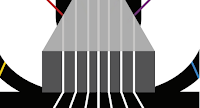Light dispersion
If a beam of white light through a glass prism separates the rainbow of seven colors. Red, orange, yellow, green, blue, indigo and violet are the seven colors that Newton listed first. Are the colors that make up white light.A monochromatic light, which we have spoken in the Laser post is one that consists of a single color, with a single frequency.

The polychromatic light consists of a mixture of colors with different frequencies. Thus, each frequency is refracted at a different angle, each frequency radiation follows a different route and seven colors appear separated.
According to Newton, the angle of refraction is greater the higher the frequency of the light. It is because of the dispersion of light, for example, form the rainbow in the sky. In a very simplified way, just replace the prism of our poster for a drop of water ... and imagine!
Curiosity
The sky is blue due to scattering of sunlight by the atmosphere which causes, from all directions, comes in bluish light. The reduced dimensions of the air molecules cause the shorter wavelengths, such as blue and violet, suffer major deviations white when sunlight shines on them. Therefore, the more "spread" color is blue, prevailing over the other and giving the sky its characteristic color.
Photograph of our own. Lavadores Beach, Vila Nova de Gaia.
At dawn and dusk because of the position of the sun, the light reaches us more inclined and must traverse a greater distance through the atmosphere, as we saw in the previous article. This causes the blue is more absorbed and the light that reaches our eyes pass to have a more reddish hue.

























